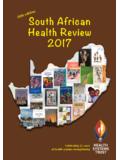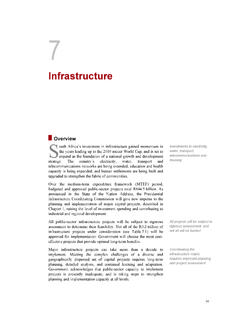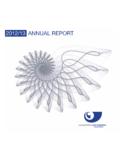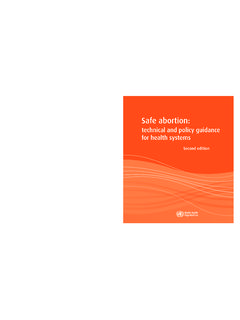Transcription of GLOBAL TUBERCULOSIS REPORT 2012 - WHO | …
1 GLOBAL TUBERCULOSIS i03/10/12 21:52 WHO Library Cataloguing-in-Publication DataGlobal TUBERCULOSIS REPORT epidemiology. , Pulmonary prevention and control. economics. observed therapy. outcome. health programs organization and administration. Health 978 92 4 156450 2 (NLM classifi cation: WF 300) World Health Organization 2012 All rights reserved. Publications of the World Health Organization are available on the WHO web site ( ) or can be pur-chased from WHO Press, World Health Organization, 20 Avenue Appia, 1211 Geneva 27, Switzerland (tel.: +41 22 791 3264; fax: +41 22 791 4857; e-mail: Requests for permission to reproduce or translate WHO publications whether for sale or for noncommercial distribution should be addressed to WHO Press through the WHO web site ( ).The designations employed and the presentation of the material in this publication do not imply the expression of any opinion what-soever on the part of the World Health Organization concerning the legal status of any country, territory, city or area or of its authori-ties, or concerning the delimitation of its frontiers or boundaries.)
2 Dotted lines on maps represent approximate border lines for which there may not yet be full mention of specifi c companies or of certain manufacturers products does not imply that they are endorsed or recommended by the World Health Organization in preference to others of a similar nature that are not mentioned. Errors and omissions excepted, the names of proprietary products are distinguished by initial capital reasonable precautions have been taken by the World Health Organization to verify the information contained in this publication. However, the published material is being distributed without warranty of any kind, either expressed or implied. The responsibility for the interpretation and use of the material lies with the reader. In no event shall the World Health Organization be liable for damages arising from its use. Cover design by Tom Hiatt, Western Pacifi c Regional Offi ce, WHO.
3 The front cover illustrates the contribution of different sources of funding to TB care and control in low-income countries, highlighting the importance of international donor funding (coloured blocks) compared with domestic contributions (grey band) as well as the role of the GLOBAL Fund (red line) that is the leading source of international donor funding globally; see Figure The back cover illustrates the impressive reduction in TB prevalence in Cam-bodia, a low-income and high-burden country, between 2002 (when a baseline national TB prevalence survey was implemented) and 2011 (when a repeat national TB prevalence survey was implemented); see Box in Chapter by minimum graphicsPrinted in FranceWHO/HTM/ ii03/10/12 21:52 GLOBAL TUBERCULOSIS REPORT 2012 iiiContents Abbreviations ivAcknowledgements vExecutive summary 1 Chapter 1.
4 Introduction 3 Chapter 2. The burden of disease caused by TB 8 Chapter 3. TB case notifi cations and treatment outcomes 29 Chapter 4. Drug-resistant TB 41 Chapter 5. Financing TB care and control 52 Chapter 6. Diagnostics and laboratory strengthening 66 Chapter 7. Addressing the co-epidemics of TB and HIV 74 Chapter 8. Research and development 82 Annexes1. Methods used to estimate the GLOBAL burden of disease caused by TB 912. Country profi les 1053. Regional profi les 1294. GLOBAL , regional and country-specifi c data for key indicators iii08/10/12 10:53iv GLOBAL TUBERCULOSIS REPORT 2012 AbbreviationsAFB acid-fast bacilliAFR WHO african RegionAIDS acquired immunodefi ciency syndromeAMR WHO Region of the AmericasARI annual risk of infectionART antiretroviral therapyBCG Bacille-Calmette-Gu rinBRICS Brazil, Russian Federation, India, China.
5 South AfricaCDR case detection rateCPT co-trimoxazole preventive therapyCBC community-based TB care DOT directly observed treatmentDOTS the basic package that underpins the Stop TB StrategyDR-TB drug-resistant tuberculosisDRS drug resistance surveillance or surveyDST drug susceptibility testingECDC European Centre for Disease Prevention and ControlEMR WHO Eastern Mediterranean RegionEQA External quality assuranceERR Electronic recording and reportingEU European UnionEUR WHO European RegionFIND Foundation for Innovative New DiagnosticsGDP gross domestic productGLI GLOBAL Laboratory InitiativeGlobal Fund The GLOBAL Fund to fi ght AIDS, TUBERCULOSIS and MalariaGlobal Plan GLOBAL Plan to Stop TB, 2011 2015 GNI gross national incomeHBC high-burden country of which there are 22 that account for approximately 80% of all new TB cases arising each yearHIV human immunodefi ciency virusICD-10 International Classifi cation of Diseases (tenth revision)IGRA interferon-gamma release assayIPT isoniazid preventive therapyIRR incidence rate ratioLED Light-emitting diodeLPA Line-probe assayMDG Millennium Development GoalMDR-TB multidrug-resistant TUBERCULOSIS (resistance to, at least, isoniazid and rifampicin)
6 NGO nongovernmental organizationNTP national TUBERCULOSIS control programme or equivalentPEPFAR US President s Emergency Plan for AIDS ReliefPOC point-of-carePPM Public Private MixSEAR WHO South-East Asia RegionSRL supranational reference laboratoryTB tuberculosisTB-TEAM TUBERCULOSIS Technical Assistance MechanismTST tuberculin skin testUNAIDS Joint United Nations Programme on HIV/AIDSUNITAID international facility for the purchase of diagnostics and drugs for diagnosis and treatment of HIV/AIDS, malaria and TBUSAID United States Agency for International DevelopmentVR Vital registrationWHA World Health AssemblyWHO World Health OrganizationWPR WHO Western Pacifi c RegionXDR-TB Extensively drug-resistant TB, defi ned as MDR-TB plus resistance to a fl uoroquinolone and at least one of three injectable second-line drugs (amikacin, kanamycin or capreomycin)ZN Ziehl iv03/10/12 21:52 GLOBAL TUBERCULOSIS REPORT 2012 vAcknowledgements This REPORT on GLOBAL TUBERCULOSIS care and control was produced by a core team of 13 people: Hannah Monica Dias, Dennis Falzon, Christopher Fitzpatrick, Katherine Floyd, Philippe Glaziou, Tom Hiatt, Christian Lienhardt, Linh Nguy-en, Charalambos Sismanidis, Hazim Timimi, Mukund Uplekar, Wayne van Gemert and Matteo Zignol.
7 The team was led by Katherine Floyd. Overall guidance was provided by the Director of the Stop TB Department, Mario data collection forms (long and short versions) were developed by Philippe Glaziou and Hazim Timimi, with input from staff throughout the Stop TB Department. Hazim Timimi led and organized all aspects of data management. Christopher Fitzpatrick, In s Garcia and Andrea Pantoja conducted all review and follow-up of fi nancial data. The review and follow-up of all other data was done by a team of reviewers that included Annabel Baddeley, Annemieke Brands, Hannah Monica Dias, Dennis Falzon, Linh Nguyen, Hazim Timimi, Wayne van Gemert and Matteo Zignol in WHO headquarters, Tom Hiatt in the Western Pacifi c Regional Offi ce, and Suman Jain, Sai Pothapregada and Moham-med Yassin from the GLOBAL Fund. Data for the European Region were collected and validated jointly by the WHO Regional Offi ce for Europe and the European Centre for Disease Prevention and Control (ECDC), an agency of the European Union based in Stockholm, Sweden.
8 Philippe Glaziou and Charalambos Sismanidis analysed surveillance and epidemiological data and prepared the fi gures and tables on these topics, with assistance from Tom Hiatt. Tom Hiatt, Linh Nguyen and Annabel Baddeley analysed TB/HIV data and prepared the associated fi gures and tables. Dennis Falzon and Matteo Zignol analysed data and prepared the fi gures and tables related to drug-resistant TB, with assistance from Shu-Hua Wang. Christopher Fitzpatrick analysed fi nancial data, and prepared the associated fi gures and tables. Tom Hiatt and Wayne van Gemert prepared fi gures and tables on laboratory strengthening and the roll-out of new diagnostics. Christian Lienhardt and Karin Weyer prepared the fi gures on the pipelines for new TB drugs, diagnostics and vaccines, with input from the respective Working Groups of the Stop TB Partnership.
9 Tom Hiatt checked and fi nalized all fi gures and tables in an appropriate format, ensuring that they were ready for layout and design according to schedule, and was the focal point for communications with the graphic writing of the main part of the REPORT was led by Katherine Floyd, with contributions from the following people: Philippe Glaziou, Charalambos Sismanidis and Jinkou Zhao (Chapter 2); Hannah Monica Dias, Haileyesus Getahun, Thomas Joseph and Mukund Uplekar (Chapter 3); Christopher Fitzpatrick and Christian Gunneberg (Chapter 5); and Annabel Baddeley, Haileyesus Getahun and Linh Nguyen (Chapter 7). Chapter 4, on drug-resistant TB, was prepared by Dennis Falzon and Matteo Zignol, with input from Katherine Floyd, Philippe Glaziou, Ernesto Jaramillo and Chara-lambos Sismanidis. Chapter 6, on diagnostics and laboratory strengthening, was prepared by Wayne van Gemert, with input from Christopher Gilpin, Fuad Mirzayev and Karin Weyer.
10 Chapter 8, on research and development, was written by Christian Lienhardt, Karin Weyer and Katherine Floyd, with input and careful review by the chairs and secretariats of the Working Groups of the Stop TB Partnership: particular thanks are due to Michael Brennan, Uli Fruth and Jenni-fer Woolley (new vaccines); Daniella Cirillo, Philippe Jacon and Alessandra Varga (new diagnostics); and Cherise Scott and Mel Spigelman (new TB drugs). Karen Ciceri edited the entire 1, which explains methods used to produce estimates of the burden of disease caused by TB, was written by Philippe Glaziou, Katherine Floyd and Charalambos Sismanidis; we thank Colin Mathers of WHO s Mortality and Burden of Disease team for his careful review and helpful suggestions. The country profi les that appear in Annex 2 and the regional profi les that appear in Annex 3 were prepared by Hazim Timimi.

















